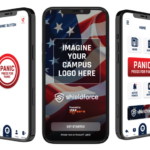On Oct. 24, 2014, a shooting at a high school in the state of Washington left five students dead. The gunman was a popular football player who had been named homecoming prince the week before the shooting. Classmates described him as “a really nice kid” and “generally happy.” In other words, it seemed like a completely unpredictable and unpreventable tragedy.
Review the shooter’s twitter feed, however, and a completely different view comes to light. In the year leading up to the shooting, the student began publishing progressively more tormented posts as his relationship with a classmate fell apart.
“It’s rarely an isolated incident, there’s always a pattern,” says Gary Margolis of Social Sentinel Inc., a social media monitoring service provider.
Margolis, who left his law enforcement career of more than 20 years to found Social Sentinel, has joined a wave of companies that have begun harnessing data from social media to provide security solutions to schools.
RELATED: Tackling Social Media Monitoring’s Liability, Clery Compliance Questions
For years these companies have been aggregating data from social media platforms and enhancing filters that they say give schools information in a way that’s effective (and manageable) enough to help them keep their students safe. It’s an industry that’s growing rapidly as the technology improves and a growing number of school administrators realize its value.
“I see this as a standard platform across all physical security environments in education, and it’s only getting deeper, richer and more effective,” Phil Harris, co-founder of Geofeedia, says. “People are telling you what’s happening on your campus, and our job is to make it easy to get the most relevant information.”
But, as with all new technologies, there are disagreements about the best ways to use the information and uncertainties regarding its future. To get a better understanding of this evolving field, Campus Safety talked with providers, end users and experts about the direction of social media monitoring.
What is it?
For years, people like stock traders and marketers have collected data from social media platforms. Although universities and school districts are the most common type of user in the security field, cities and police departments have also started using the data.
“We’re seeing a lot of partnerships between schools and the local public safety community and law enforcement groups to achieve a common mission,” Harris says.
As schools and colleges get started with these services, social media monitoring companies will set up geofences, or virtual barriers, around their campuses to determine a pool of activity to focus on. In some key ways, the companies differ in their techniques for gathering social media information. Some companies stick to tightly-defined, campus-centric geofences, while others are open to evaluating data from troubled locations outside campus, even searching specific people’s accounts regardless of their location.
“We build filters for whatever the school wants to look for, whether it’s bullying, drugs, fights,” Derek Peterson, founder of Digital Fly, says. “Then our customers see those results in a report or live onscreen, because if I was trying to see every post from every platform, I’d be trying to boil the ocean. So it’s about narrowing things down.”
RELATED: Using Social Media to Catch the Bad Guys
Companies also add value to similar posts coming from the same location.
“If we’re getting multiple posts from different people, it’s a higher alert degree,” Harris explains. “Because if three people are using the word ‘fight,’ there’s probably something going on.”
Most of the companies purchase data from social media sites. Some stick to the “big three” of Twitter, Facebook and Instagram, while others will go through Youtube, Flickr and Picasa, along with international sites like Weibo (China) and VK (Russia).
Of course, not all social media platforms are open to the data mining.
“There are some social media services that don’t provide their information publicly, which is fine. They’re making business decisions,” Margolis says, “but we’re actively building relationships with those companies.”
How Does it Work?
“The first thing we do is ask ‘What are the acronyms of your school?'” Peterson says. “Then it’s ‘What is the terminology you’re looking to track?’ Then we set up the geofence, and so what’s nice is when an incident does occur, schools can go back and search for evidence or anything in the data.”
Because it’s such a new industry, companies are eager to teach their clients how to maximize the value of their service. Companies do everything from providing online and in-person training, assigning each client to a customer care team and hosting annual conferences for clients to discuss best practices.
“We’re really partnering with our customers throughout the process,” Harris says. “It isn’t just them buying the software. It’s finding the appropriate use of social media. It’s all evolving and so there’s an education barrier. Our goal is to provide as much education as we can.”
Schools can set up geofences around one building or multiple buildings across different campuses. Sports stadiums and other school buildings have also been selected.
“We’ve spent a lot of time and effort and brainpower developing our service around each school’s particular needs,” Margolis says.
RELATED: Measuring Campus Health with Social Media
Many of the companies simply provide software-as-a-service, so there’s rarely any installation process or IT involvement. Still, schools sometimes struggle to find the resources needed to devote to the service. Smaller schools will sometimes designate one person to oversee the operation, whereas larger schools, universities and K-12 districts might give that responsibility to their public safety departments. Revere Public Schools in Massachusetts, for example, elects to receive one report a day from Social Sentinel.
“We have our school resource officer involved with accessing the service and our technical director as well,” Revere Public Schools Superintendent Chris Malone says. “But predominantly, I’m the one who diligently reads the messages and then re-forwards the information to administrators who would want to take a closer look or follow up, although long term I’m probably not the ideal person to be monitoring this stuff.”
Malone’s district began working with Social Sentinel two years ago to determine which terms should be flagged and which ones would turn up too many false alarms.
“Most terms were suggestions from Social Sentinel where I’d describe an issue and let them give me feedback, saying ‘Okay, if that’s an issue, here are some keywords to look for,'” Malone says. “So it’s a lot of back and forth because we weren’t sure how to manage it at first.”
Malone believes it’s important to give the people checking the data the power to make important decisions and the resources to react to any threats they may find.
RELATED: Tackling Social Media Monitoring’s Liability, Clery Compliance Questions
Should Schools Be Concerned About Privacy?
Privacy is the most obvious concern people might have with social media monitoring. In fact, some companies don’t like the term “social media monitoring” because they say it makes them sound like Big Brother. They’re quick to point out that everything they’re looking at is coming from public domains. Further, the companies talk to their clients about the ways their information gathering is to be used.
“We’re clear with our clients that this is an alert service not a monitoring service,” Margolis explains. “We give schools a framework to operate efficiently and consistently. It’s not built for fishing expeditions; it’s designed to help our customers understand what’s happening or what’s happened on their campus.”
Harris thinks schools have an obligation to check social media activity.
“For schools, it’s all about, ‘I’m trying to protect this public place that is my campus, and it’s my mission to keep the people on my campus safe,'” he says. “This isn’t an individual tracker. It looks at trends to find issues.”
Malone admits he sometimes sees kids talking about things that aren’t appropriate, but he’s only interested in threatening behavior.
RELATED: Using Situational Awareness to Identify Pre-Attack Indicators
“Unless we think someone’s significantly in danger or there’s a serious issue, we probably won’t intervene,” he says.
Director of Campus Safety for the Claremont Colleges Stan Skipworth, who also heads a consulting firm for public safety organizations, says schools and universities have to use the service consistently and carefully.
“There is a balance that has to be pursued, and the people involved have an incentive to make sure they’re using this technology in a way that is respectful and considerate to people’s privacy,” he says.
At this point, there are no laws explicitly allowing or forbidding the collection of social media data, but Skipworth is aware of bills that have come up “from time to time” in California seeking to fill in that gray area.
Because this is such a new technology, Harris says the policies and legislation surrounding it are still evolving.
“Like any new market, there are policies and procedures that need to get developed, but I think all of that will be addressed in the next year or so,” he says.
Does it work?
When considering the potential risks and unsettled legal questions surrounding social media monitoring, some may question if the service is worth it. Schools that use it, however, don’t seem to question their decision at all.
“The first big moment for us was when I made a technical support phone call to Social Sentinel on an issue and the technician said ‘I want to tell you, you have someone tweeting from the high school gym that she wants to kill herself right now,'” Malone remembers. “And he was able to forward me the posting. So I contacted the assistant principal in the high school, and within minutes he’d identified the girl, looked up her schedule and got a hold of her. It turned out the girl was just making fun or whatever, but it was a big ‘Ah ha!’ moment for us.”
Harris recalls an incident in Kennedy, Ariz., when Geofeedia helped a school find a student on social media who was announcing he was going to kill a teacher and classmates on campus the next day. Administrators alerted police, who detained the boy and searched his house. Although the boy claimed he wasn’t going to do anything, authorities recovered an automatic weapon from his home.
“We’ve had customers call us and tell us that they’ve prevented a suicide; we’ve had customers letting us know they’ve been able to intervene in drug activity and drug sales or identify and address issues during major sporting events,” Margolis says. “So we’ve had many successes in that regard.”
Expect More Robust Offerings in the Future
As the technology improves, more features will be added onto the service. Multiple companies currently have object recognition in their research and development phase, which will allow them to alert school officials if someone posts a picture of a weapon.
“If you compare the cost of a social media platform to the installation of ten surveillance cameras, it’s a fraction of the cost,” Harris claims. “And I would argue that it can be far more powerful in many ways than video surveillance.”
So perhaps it’s no surprise that more and more schools are giving it a try. Margolis was attending a PTO meeting at his daughter’s school recently when the principal launched into an unexpected explanation of the purpose of checking social media.
“I used to be able to look at social media and say ‘that’s not my world'” Margolis recalls the principal saying. “But as a school administrator, I can’t do that anymore. I have an obligation to pay attention to social media and to pay attention to the things students say and the behaviors they exhibit on social media because I have a responsibility to protect my students.”













